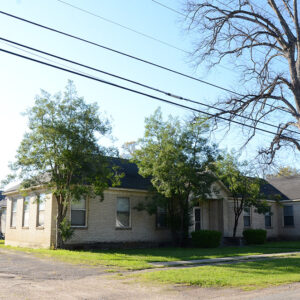calsfoundation@cals.org
Dr. E. P. McGehee Infirmary
Located in Lake Village (Chicot County), the Dr. E. P. McGehee Infirmary served as a healthcare facility for both white and African American residents of the surrounding area. After the facility’s service as a medical infirmary ended, the Museum of Chicot County operated there for a period. It was added to the National Register of Historic Places on June 1, 2005.
Born in Alabama in 1869, Edward Pelham (E. P.) McGehee studied at Southern University in Greensboro, Alabama, as well as Vanderbilt University and the University of Mobile. After opening a practice in Alabama, he moved to Lake Village in 1899 and set up an office in the John Tushek Building. He married Sue Gordon McMurray in 1904, and the couple purchased a house on South Cokley Street in 1910.
Over the next four decades, McGehee expanded the original house and moved other structures to the property to offer more services to his patients. His family lived in the house for several years until they built a home across the street.
The original house at the site was a wooden Victorian structure. The structure faces east, and the eastern side of the building includes three hospital wings, covered in buff brick. The rear of the building includes a wing originally constructed to offer medical services to African American patients. An emergency room was located on the northern portion of the building with covered concrete ramps providing access.
The entire structure includes the original wood-frame house, at least one Craftsman-style home moved to the site between the 1920s and 1940s, and multiple additions. The various parts of the building are topped with both flat and gabled roofs. The Craftsman-style home added to the building is a two-story structure, while the rest of the building is single story. The second story of the building was used as apartments for nurses working at the infirmary. McGehee also kept a private apartment in the building to rest between seeing patients. The buildings were added in a way that created a small courtyard located on the eastern side of the infirmary, near the emergency room.
To make the various structures work as a hospital, interior modifications were made such as skylights added throughout the building. The building included both an air-conditioning system and X-ray facilities. After the Flood of 1927, McGehee renovated the existing building and had much of it covered with buff brick. The surgery room located at the rear of the structure is covered with asbestos siding.
McGehee operated the facility until his death from cancer in 1950. He held various roles during his decades in Arkansas, including service as the secretary/treasurer of the Arkansas Medical Society and as a member of the local school board. Other doctors operated the infirmary until a new hospital for the area was constructed in 1967. A clinic continued to operate in part of the building until 1973.
The facility housed the Museum of Chicot County after the closure of the clinic, but by 2024, it was abandoned and in disrepair.
For additional information:
“Dr. E. P. McGehee Infirmary.” National Register for Historic Places registration form. On file at Arkansas Historic Preservation Office, Little Rock, Arkansas. Online at https://www.arkansasheritage.com/docs/default-source/national-registry/CH0168-pdf (accessed March 1, 2024).
David Sesser
Southeastern Louisiana University
 Early Twentieth Century, 1901 through 1940
Early Twentieth Century, 1901 through 1940 Health and Medicine
Health and Medicine Historic Preservation
Historic Preservation Dr. E. P. McGehee Infirmary
Dr. E. P. McGehee Infirmary 




Comments
No comments on this entry yet.